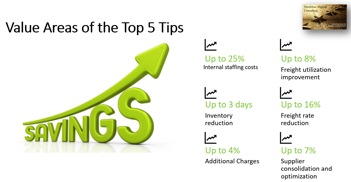
Think Tank
Five Tips for Optimizing Healthcare Supply Chains

Healthcare supply chains tend to be high-margin, regulated businesses with strict quality requirements, such as the need for cold-chain storage and transportation. Yet they’re often ripe for improvements across the board.
Inefficiencies often crop up due to the outsourcing of capability to logistics service providers (LSPs) without appropriate control, the cross-border nature of many products, and complex regulations that often are not adequately understood.
Companies in the sector can realize significant improvements in a number of key areas, including cost, inventory and working capital, service quality, and sales. Potential benefits are many, including:

Here are five tips for optimizing healthcare supply chains:
Target your suppliers. One of the easiest places to start is by consolidating or improving the management of your supplier base. A large portion of overall supply-chain spend lies with the purchase of materials, products and services. This might include LSPs, warehouse suppliers, raw-material providers, and re-packagers. Once you outsource such capabilities, however, you must manage them effectively — or they will manage you.
Companies seeking to consolidate suppliers and contracts should do the following:
- Maximize your volumes. Consolidate your warehouse and LSP partners through a few key parameters.
- Build win-win contracts. Standardize contracts, including terms, that build true partnerships. Make it a gain-share/pain-share collaboration.
- Re-tender. This is to help you understand the market and keep suppliers competitive. Better yet, build a fully open contract.
When it comes to ensuring supplier performance and continuous improvement:
- Measure on a regular cadence. Put in a balanced scorecard of performance and run monthly, quarterly and annual performance reviews.
- Measure the delta improvement. Is it changing over time, as it should? If not, why not?
- Assess the continuous-improvement program against the maturity of your supply chain.
By focusing on these two areas, you’ll see big improvements in supplier cost and service.
Focus on performance. Define and drive a hierarchy of outcome-based supply-chain measures that are meaningful to your customers. They should be broad and deep, and allow for analysis of tradeoffs between key performance indicators (KPIs). Of all the tips, this one is probably the most important to driving real and ongoing improvements.
Companies should build an industry-based, tiered KPI model focusing on cost, cash, service and quality. KPIs should be comprehensive and measure your full supply chain, including manufacturing, distribution, planning, forecasting, and finance. Use industry benchmarks including APICS, POBOS, and Gartner guidelines to assess and help set targets. You might have multiple supply chains within a single company, each with different targets and focuses.
Set targets at every level of the organization. Get the highest level of business support to enforce target-setting in various parts of the supply chain. Aim for real-time visibility of performance data for all staff and suppliers.
Keep a focus on daily, weekly, monthly and annual performance through target-setting at all levels, in order to achieve a 20% year-on-year improvement in key indicators.
Enable visibility. Knowing where your finished goods are in the supply chain at any given moment drives a wealth of optimization opportunities. But it isn’t as easy as it sounds.
Get your key data together. Invest in the basics, keeping your data in one place for analysis. This includes information on products and SKUs, manufacturing sites, distribution centers, shipping lanes, modes, suppliers and customers.
Build your analytical capability from end to end. In addition, think about deploying software platforms designed for this purchase. Leverage new capabilities in the field, including artificial intelligence. If you choose to buy an analytical service, seek out a fourth-party logistics (4PL) or strong third-party logistics (3PL) provider.
Understand your costs. It sounds basic, but many companies don’t understand how much and where their costs are. This can also be complicated to assess, due to the lack of a single source of the truth around supply-chain spend, as well as inaccurate or missing data.
Collect your cost-of-goods and cost-to-serve data as often as possible. Group it into standard categories for benchmarking and further assessment. Look for when cost patterns are falling outside the norm, and benchmark internally and externally.
Go to the lowest level of data — the invoice — to understand where savings opportunities are. In the process, you’ll uncover any non-standard cost patterns. And kick off projects that standardize and remove waste.
Standardize, standardize, standardize. Many large-scale organizations have grown through acquisition, which inevitably leads to a multitude of processes and systems developing over the years. In addition, more decentralized companies allow local or regional parts of the business to act independently in some ways. This leads to many opportunities to improve across the board.
Standardize physical and financial processes, using industry-standard frameworks such as the Supply Chain Operations Reference (SCOR) model. (And don’t forget master data!) Enforce standards through top-down sponsorship, and be sure and include suppliers and customers.
Measure the performance of your in-process steps and key output levers to see how well they’re “sticking.” Link local, regional and global performance, and benchmark regularly (while taking the results with a grain of salt).
It’s not easy to kick down walls across the organization, and get everyone thinking and executing the process consistently, but it’s worth it. Having a standard global process doesn’t mean you can’t have local variations; they just have to be managed.
There’s a wealth of opportunity to improve the typical healthcare supply chain. The key is getting started with a coherent structure. Every day you wait is another lost sale, higher costs, and a less-profitable business. Change requires adopting a firm focus and providing unwavering support from the top. And don’t forget to draw on outside experts in the field and industry frameworks to help you in your journey. You don’t have to start from scratch and do it all yourself.
James Hickland is managing partner of Northstar Aligned Consulting LLC.






